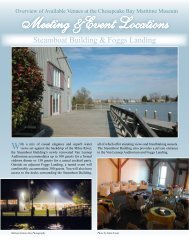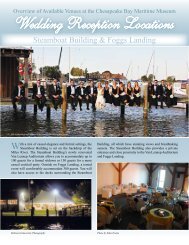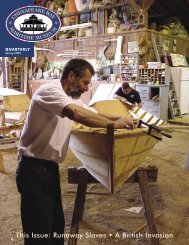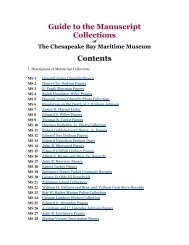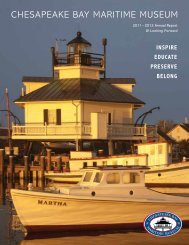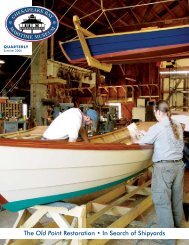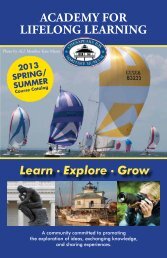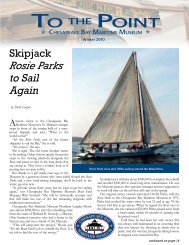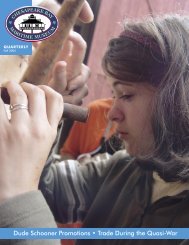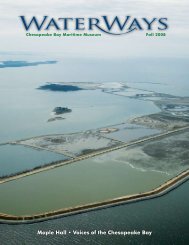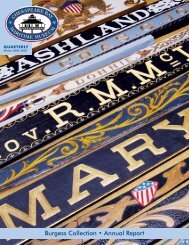Spring 2008 - Chesapeake Bay Maritime Museum
Spring 2008 - Chesapeake Bay Maritime Museum
Spring 2008 - Chesapeake Bay Maritime Museum
Create successful ePaper yourself
Turn your PDF publications into a flip-book with our unique Google optimized e-Paper software.
<strong>Chesapeake</strong> <strong>Bay</strong> <strong>Maritime</strong> <strong>Museum</strong> <strong>Spring</strong> <strong>2008</strong><br />
<strong>Chesapeake</strong> Shipbuilding • Hooper Strait Lighthouse
The convenience of<br />
Chevy Chase Bank<br />
at your fingertips.<br />
Open a Chevy Chase Bank checking account and get:<br />
• The most branches and ATMs<br />
• Extended branch hours<br />
• Free Direct Deposit Checking*<br />
• Free Chevy Chase Check Card<br />
• Free Online Banking<br />
• Free online bill payment<br />
• Free Change Express ® coin-counting<br />
service<br />
For more information, call 301-987-BANK, 1-800-987-BANK (out-of-area),<br />
or visit chevychasebank.com.<br />
*There is no minimum balance requirement and it’s free as long as you<br />
have a monthly direct deposit into your account.
St Michaels Office: 210 S. Talbot Street<br />
Tom Crouch 410.310.8916<br />
Debra Crouch 410.924.0771<br />
Office 410.822.3456<br />
www.cbmove.com/TomandDebra<br />
TALBOT COUNTY, MARYLAND<br />
We have the area’s finest waterfront building sites...Ranging from 3 to 196 acres...<br />
Priced from $699,000 to $7.9 million<br />
Tom and Debra Crouch<br />
“Specializing in Fine<br />
Talbot County Properties”<br />
WATERFRONT ESTATES<br />
Including this amazing “French Country-style” home on<br />
a premier 8-acre point. $3,100,000<br />
CONTEMPORARY WATERFRONTS<br />
Including this just-completed 7,500 sq. ft. home, waterside<br />
pool, deep water dock. $3,950,000<br />
HISTORIC HOMES<br />
Including this grand c. 1790 Georgian home w/7 bedroom<br />
suites. Zoning allows Inn/B&B. $1,990,000<br />
WATERFRONT RETREATS<br />
Including this perfect family compound...3 cottages, sandy<br />
beach, privacy, sunsets! $1,795,000
On the Cover<br />
WaterWays<br />
<strong>Spring</strong> <strong>2008</strong><br />
Volume 6 Number 1<br />
Editor<br />
Michael Valliant<br />
editor@cbmm.org<br />
Graphic Design/Photography<br />
Rob Brownlee-Tomasso<br />
Contributors<br />
Dick Cooper<br />
Robert Forloney<br />
Pete Lesher<br />
Melissa McLoud<br />
John Miller<br />
Stuart Parnes<br />
Kathleen Rattie<br />
<strong>Chesapeake</strong> <strong>Bay</strong> <strong>Maritime</strong> <strong>Museum</strong><br />
Navy Point, P.O. Box 636<br />
St. Michaels, MD 21663-0636<br />
410-745-2916 • Fax 410-745-6088<br />
www.cbmm.org • editor@cbmm.org<br />
The <strong>Chesapeake</strong> <strong>Bay</strong> <strong>Maritime</strong> <strong>Museum</strong> is a private<br />
not-for-profit 501(c)(3) educational institution. A<br />
copy of the current financial statement is available<br />
on request by writing the Vice President of Finance,<br />
P.O. Box 636, St. Michaels, MD 21663 or by calling<br />
410-745-2916 ext. 238. Documents and information<br />
submitted under the Maryland Charitable Solicitations<br />
Act are also available, for the cost of postage and<br />
copies, from the Maryland Secretary of State, State<br />
House, Annapolis, MD 21401, 410-974-5534.<br />
A new mast for the skipjack Stanley<br />
Norman, photo by Nikki Davis. Davis<br />
is currently a photography student at the<br />
Center for Digital Imaging Arts at Boston<br />
University, in Washington DC. She came<br />
to the CBMM Boat Yard to take pictures<br />
of wooden boat building.<br />
<strong>Spring</strong> Season’s Greetings<br />
It must be spring – the osprey are diving for fresh fish, tourists are re-appearing<br />
from their winter hibernation, and the <strong>Museum</strong> is bustling with preparations<br />
for a new season. Mister Jim is up on the railway for her (his) annual<br />
inspection and bottom scrub; the Lighthouse is about to re-open with all new<br />
furnishings and interpretation. New merchandise is rolling in for the <strong>Museum</strong><br />
Store, and the grounds are green and beautiful.<br />
But like so much other springtime activity, there is more going on below<br />
the surface here that is getting ready to sprout.<br />
We have begun the careful transfer of our library and archival collections<br />
from their outgrown home on North Street to a much improved location in<br />
the Research, Resource, and Collection Center on Mill Street. These precious<br />
materials will finally have the environmental and security protection that they<br />
deserve. Soon, a small addition to the facility will provide new people space<br />
for researchers, volunteers and staff. The new reference area will be a more accessible<br />
and pleasant place to work, write and study the extensive collections<br />
that comprise the <strong>Museum</strong>’s treasure trove of historical information.<br />
We are also preparing for the arrival of new artwork. Final preparations<br />
have been made for hosting the 30th Anniversary Exhibition of the American<br />
Society of Marine Artists (ASMA), which will open here in the new<br />
Steamboat Gallery on July 25. Marine art in America is flourishing, thanks<br />
in large part to the work of ASMA, which set out three decades ago to revive<br />
this rich American tradition. This spectacular juried exhibition will showcase<br />
the work of 100 artists and will include a wide array of media—oils, watercolors,<br />
pastels, scratchboard, pencil, sculpture and scrimshaw—and subject<br />
matter. In addition to the more traditional themes, such as recreational boating<br />
scenes, commercial shipping, historic vessels, or navies in battle, many of<br />
the ASMA artists have turned their attention to marine wildlife in their ocean<br />
environment and coastal habitats.<br />
Speaking of habitats, the <strong>Museum</strong> is planning to add some of its own as<br />
a new marsh exhibit along the Miles River. We will be constructing a “living<br />
shoreline” along the bulkhead that stretches from the Boat Shed past Waterman’s<br />
Wharf to the Steamboat Building. Planting won’t take place until next<br />
winter, but informational signs will appear this spring describing the project<br />
and the important environmental benefits of undertaking it. Seed money (sorry)<br />
has come through a grant from NOAA<br />
and the <strong>Chesapeake</strong> <strong>Bay</strong> Trust. Contributions<br />
for the balance of the work are now<br />
being sought from foundations and individuals.<br />
If you would like to participate in<br />
this project or its funding, please contact<br />
me for more details.<br />
History, art and science—it’s all here<br />
waiting for you, along with the special<br />
events listed later in this issue. <strong>Spring</strong><br />
on over. It’s the perfect season to enjoy<br />
your museum.<br />
Stuart L. Parnes, President<br />
sparnes@cbmm.org
Contents<br />
(Above) A <strong>Bay</strong> Day photo memory.<br />
Two of CBMM’s <strong>Bay</strong> Day visitors<br />
on April 19, take home a snapshot<br />
souvenir of the mini-skipjack, Spat.<br />
Departments<br />
To the Point 7<br />
Calendar 9<br />
Wood Works 13<br />
Mystery Answers 23<br />
Features<br />
30 Years of Marine Art<br />
A new exhibition from the American Society of Marine Artists<br />
chronicles the result of three decades of outstanding marine art.<br />
The exhibition opens at CBMM on July 26.<br />
Research & Rebirth<br />
How do you re-interpret a nearly 130-year-old <strong>Chesapeake</strong> lighthouse<br />
You tell the stories of the people who lived and worked in it. To pull<br />
that off, you better do your research. By Melissa McLoud.<br />
Destination: <strong>Chesapeake</strong> <strong>Bay</strong><br />
14<br />
16<br />
Cruise ships have found the small <strong>Bay</strong> port towns such as St. Michaels<br />
and Oxford. American Cruise Lines has found a niche creating unique,<br />
off-the-path experiences for their travelers. By Dick Cooper<br />
19<br />
This issue of WaterWays was underwritten, in part, by the Talbot County Office of Tourism.<br />
Visit www.tourtalbot.org.<br />
5
Kids Club<br />
(formerly <strong>Bay</strong> Combers)<br />
at the <strong>Chesapeake</strong> <strong>Bay</strong> <strong>Maritime</strong> <strong>Museum</strong><br />
NEW!<br />
Week long, half-day camp<br />
for ages 4 & 5 and 6 & 7<br />
Camp led by educator Martha Hamlyn<br />
4 & 5 year olds<br />
9:30 to 12:30<br />
week of June 23-27<br />
6 & 7 year olds<br />
9:30 to 12:30<br />
week of June 30-July 4<br />
Themes each day:<br />
Monday<br />
A Pirate’s Life for Me<br />
Don your pirate costume<br />
and come eager to learn<br />
about these outlawed<br />
sailors. Listen to stories,<br />
play games and hunt<br />
for treasure.<br />
Tuesday<br />
The <strong>Bay</strong> Below Us<br />
Discover surprises under<br />
the surface of the Miles<br />
River. Voyage on the<br />
buyboat Mister Jim to<br />
experience wildlife and<br />
pull up a dredge to create<br />
a living touch tank.<br />
Wednesday<br />
Living in a Lighthouse<br />
Explore the new handson<br />
activities in the lighthouse.<br />
Open doors and<br />
peek through cabinets<br />
and closets to learn about<br />
the lighthouse keepers’<br />
lives and work.<br />
Thursday<br />
Row, Row, Row<br />
Your Boat<br />
Merrily row in a small<br />
skiff with an adult while<br />
learning about boating<br />
safety. Back on shore,<br />
see other types of <strong>Bay</strong><br />
boats at the <strong>Museum</strong>.<br />
Friday<br />
<strong>Chesapeake</strong> Feasting<br />
Come with a big appetite<br />
for a <strong>Chesapeake</strong> feast.<br />
Learn why the <strong>Bay</strong> is<br />
considered the greatest<br />
seafood factory and try<br />
your skill at chicken necking<br />
for crabs. Together<br />
we’ll prepare and eat a<br />
crab cake feast.<br />
4 & 5 year olds<br />
9:30 to 12:30<br />
week of July 7-11<br />
Themes each day:<br />
Monday<br />
Woodland Indians<br />
Step back in time and<br />
imagine life in a Nanticoke<br />
tribe. Hear stories<br />
and learn about the lives<br />
of the first people who<br />
lived along the <strong>Bay</strong>.<br />
Tuesday<br />
The Eyes of an Artist<br />
Put on special “eyes” to<br />
see brand new things in<br />
the <strong>Museum</strong>’s art collection.<br />
Then we’ll get out<br />
the paint and brushes<br />
and see what we can do!<br />
Wednesday<br />
Marsh Mucking<br />
Find out who lives (and<br />
who hides!) in those<br />
great, gunky, grassy<br />
marshes! Learn why<br />
marshes are important<br />
for animals and people.<br />
6 & 7 year olds<br />
9:30 to 12:30<br />
week of July 14-18<br />
Thursday<br />
Float that Boat<br />
Aspiring shipwrights will<br />
visit a working boat yard,<br />
meet boat builders and<br />
learn about building a<br />
craft. Then, we’ll experiment<br />
with what floats<br />
and what doesn’t.<br />
Friday<br />
Play on Our <strong>Bay</strong><br />
Go on an adventure and<br />
discover ways you can enjoy<br />
the <strong>Bay</strong>. See how kids<br />
and adults have played<br />
on the <strong>Bay</strong>. You’ll go fishing<br />
off the dock, too.<br />
<strong>Chesapeake</strong> <strong>Bay</strong><br />
<strong>Maritime</strong> <strong>Museum</strong><br />
Navy Point w PO Box 636<br />
St. Michaels, Maryland 21663<br />
410-745-2916 w cbmm.org<br />
*Members: $100/week<br />
Non-members: $120/week<br />
* Membership rates apply only if camper’s parent or guardian is a member.<br />
Program fee includes activities and snack. Cancellation Policy: There<br />
will be no refund for cancellations made within 7 business days of your<br />
program date. Cancellations 7-30 days will get a 50 % refund and more<br />
than 30 days will be entitled to a full refund.<br />
Kids Club is partially funded by the Jim and Patty Rouse<br />
Charitable Foundation, Inc.<br />
Space is limited and pre-registration is required. Scholarships are available for qualifying<br />
students. For more information or to register, call 410-745-2916 or e-mail education@cbmm.org
To the Point<br />
<strong>Museum</strong> Welcomes<br />
23 New Docents<br />
Members of the <strong>Spring</strong> <strong>2008</strong> class of CBMM docents, along with<br />
CBMM director of education Robert Forloney, during one of the<br />
final training sessions.<br />
Once through our admissions building, the first person a<br />
CBMM visitor is likely to encounter is one of our docents.<br />
From a friendly greeting, to a thought-provoking, interactive<br />
tour of the <strong>Museum</strong>, to fielding questions and giving<br />
lunch and shopping recommendations, the CBMM docents<br />
enhance and help create our visitor experience.<br />
This spring, 23 new docents completed the nine-week<br />
training program making this the largest class in more than<br />
ten years.<br />
“Our latest docent class was the largest in recent memory<br />
and this is incredibly important due to the widely expanded<br />
educational programming now offered at CBMM,” says Director<br />
of Education Robert Forloney. “Docents are the public<br />
face of the institution. They guide visitors by facilitating interactive<br />
experiences, leading demonstrations, and assisting<br />
with special classes. We simply could not function without<br />
this core group of volunteers.”<br />
The nine-week docent training course leads participants<br />
through an orientation to the <strong>Museum</strong> and its exhibits, boats,<br />
and collection; provides background on the history of the<br />
<strong>Bay</strong> and the regional community; and covers interpretive<br />
techniques, how to build and lead tours, how to teach with<br />
objects and other hands-on learning opportunities.<br />
Congratulations to the <strong>2008</strong> docent class! To learn more<br />
about docent training and other volunteer opportunities,<br />
please contact Volunteer Administrator Melissa Spielman at<br />
410-745-2916, ext. 252, or e-mail mspielman@cbmm.org.<br />
Lad Mills Needs… You!<br />
This year’s annual Boat Auction is fast approaching on<br />
Saturday, August 30, but Lad Mills, CBMM’s boat donations<br />
program manager stays hard at work throughout the<br />
year. Lad tirelessly searches for boats to be donated as well<br />
as finding homes for donated boats year-round. Revenue<br />
generated by boat sales is a substantial boost to the <strong>Museum</strong>’s<br />
operating budget and helps support programs and exhibits.<br />
If you don’t mind rolling up your sleeves, Lad—and<br />
CBMM—need your help! Cleaning the boats up and detailing<br />
them does wonders for the boats’ appearance and ultimate<br />
resale value.<br />
“This is a really tangible way to do something for the <strong>Museum</strong>,”<br />
Lad says. “We’ll take all<br />
the help we can get, and there<br />
are a number of simple tasks<br />
from which we reap huge benefits.<br />
Besides, I have a hard time<br />
keeping (CBMM president) Stuart<br />
Parnes on task with a bucket<br />
and a can of AJAX, when he’s<br />
supposed to be sitting in a finance<br />
meeting!”<br />
In the end, the work and<br />
camaraderie are good fun, and<br />
Lad takes care of his volunteers—his<br />
cookout for his helpers<br />
at the end of the boat auction<br />
is another annual event. For<br />
more information or to sign up to volunteer with Lad, contact<br />
Volunteer Administrator Melissa Spielman at 410-745-2916<br />
ext. 252 or e-mail mspielman@cbmm.org.<br />
Get Out on the Miles!<br />
Cruise with Mister Jim<br />
There are a number of jobs<br />
to help get a boat ready for<br />
re-sale!<br />
CBMM’s replica buyboat Mister Jim will be taking regularly<br />
scheduled cruises throughout the summer.<br />
For years our members and visitors have been asking for<br />
opportunities to get out on the water. In 2007, we were able to<br />
respond, offering regularly scheduled cruises on our replica<br />
buyboat, Mister Jim, for the first time. These scenic cruises of<br />
the Miles River are back again for <strong>2008</strong>!<br />
On Thursdays, Fridays, Saturdays, and Sundays, Mister<br />
Jim will take regularly scheduled 45-minute tours on the<br />
Miles. The cost of non-member cruises is $12 for adults, $10<br />
7
To the Point<br />
Cruise with Mister Jim (continued)<br />
for seniors, $10 for military, and $7 for children ages 17 or<br />
under. CBMM members can cruise for $10 for adults and $6<br />
for children ages 17 or under. Cruises depart at 11 a.m., 12:30<br />
p.m., and 2 p.m.<br />
On select days this spring, summer, and early fall, CBMM<br />
is also offering cruise aboard the skipjack H. M. Krentz with<br />
Captain Ed Farley. Skipjack cruises are two-hours long and offer<br />
a unique experience to learn about working the water from<br />
the captain who took James Michener dredging for oysters!<br />
Cruises aboard the H.M. Krentz are $35, $32 for seniors,<br />
and $18 for children ages $17 and under. The cost to CBMM<br />
members is $32.<br />
All boat rides and cruises are subject to cancellation<br />
based on the weather. Please call Visitor Services at 410-<br />
745-2916 ext. 142 to confirm times and space availability on<br />
particular days.<br />
Good Bye Crab Days, Hello<br />
<strong>Chesapeake</strong> Folk Festival!<br />
CBMM now eligible for funding via<br />
the Combined Federal Campaign<br />
The <strong>Chesapeake</strong> <strong>Bay</strong> <strong>Maritime</strong> <strong>Museum</strong> has just<br />
been approved to receive funding from the <strong>Chesapeake</strong><br />
<strong>Bay</strong> Area Combined Federal Campaign (CFC).<br />
CFC is the world’s largest and most successful annual<br />
workplace charity campaign, with more than 300 CFC<br />
campaigns throughout the country and internationally to<br />
help to raise millions of dollars each year. Pledges made<br />
by Federal civilian, postal and military donors during<br />
the campaign season (September 1st to December 15th)<br />
support eligible non-profit organizations from throughout<br />
the world.<br />
The CFC provides Federal government employees<br />
with the ability to donate through payroll deduction.<br />
About 90% of CFC donors use payroll deduction, an<br />
easy and flexible way to give. Payroll deduction, combined<br />
with designations of their donation, affords Federal<br />
employees the opportunity to<br />
ensure that their contributions<br />
support the charities that they<br />
care about, like CBMM!<br />
8<br />
Crab picker “Miss Alice” Palmer, a fixture at Crab Days, will be a<br />
part of the first <strong>Chesapeake</strong> Folk Festival on July 26.<br />
If you show up at CBMM on Saturday, July 26, looking<br />
for our Crabs Days festival, you will still be able to sit down<br />
with steamed crabs, crab cakes or crab soup. But, you’ll find<br />
a lot more on campus.<br />
The <strong>Chesapeake</strong> Folk Festival, sponsored in part by the<br />
Maryland Traditions Program of the Maryland State Arts<br />
Council, will debut at CBMM that day and welcome artists,<br />
singers and aficionados of the Smith Island Cake among others<br />
to Navy Point.<br />
This year’s inaugural festival celebrates the <strong>Chesapeake</strong>’s<br />
people and traditions with the music, food, history, culture and<br />
artistic traditions that make <strong>Chesapeake</strong> region so special.<br />
The daylong celebration will focus on the wide-ranging<br />
influences of <strong>Chesapeake</strong> culture, showcasing the region’s<br />
finest artistic and musical traditions, along with a wide variety<br />
of living history, boat building, cooking and fisheries<br />
presentations with a special tribute to <strong>Chesapeake</strong> sailor Jimmy<br />
Wilson. Among those slated to perform are the singing<br />
groups, the Zionnaires and the New Gospelites.<br />
Check our website this summer for more information and<br />
put Saturday, July 26, on your calendar so you can be part of<br />
the first <strong>Chesapeake</strong> Folk Festival!<br />
ALL Comes Home<br />
CBMM’s Academy for Lifelong Learning (ALL) is on<br />
the move, literally and figuratively! With the sale of the<br />
Railroad Avenue property, ALL is returning to its birthplace<br />
on CBMM’s campus. From small beginnings in 2001, ALL<br />
has grown steadily in membership and in the number and<br />
variety of the courses it offers to its members. A broad spectrum<br />
of subjects has been presented over the years: from<br />
spirituality to sailing; from music to medicine; from poetry<br />
to painting. The <strong>Spring</strong> <strong>2008</strong> session now underway is no<br />
exception to this rule, offering twelve courses that have attracted<br />
132 participants.<br />
The <strong>2008</strong> Summer Session of ALL will take place on<br />
the <strong>Museum</strong> campus and the curriculum is in the planning<br />
stage and will include courses on Renaissance Art, Literature,<br />
and sailing events. For more information about ALL courses<br />
and membership please call 410-745-2916 or contact www.<br />
cbmm.org/all.html. w
Calendar<br />
<strong>Spring</strong>/Summer <strong>2008</strong><br />
c 1900, National Archives<br />
the water as we discuss constellations, astronomy and<br />
celestial events. The entire family will enjoy stargazing<br />
on the Miles River. Meet at Admissions Building.<br />
CBMM Members $25, Non-Members $30<br />
May<br />
Opening—Hooper Strait<br />
Lighthouse<br />
Be the first to see the re-interpreting of our own Hooper<br />
Strait Lighthouse. The story is a keeper...or about the<br />
lighthouse keepers, more specifically! Through research<br />
and rethinking, <strong>Museum</strong> staff have re-created the exhibit<br />
inside the lighthouse using the stories of the keepers.<br />
Ecology Cruise<br />
May 28, 9:30am-12:30pm<br />
Biologists Bob and A.J. Lippson, authors of Life in the<br />
<strong>Chesapeake</strong> <strong>Bay</strong>, explain the ecology of the Miles River<br />
aboard the <strong>Museum</strong>’s replica buyboat, Mister Jim. Get<br />
close to nature on this hands-on science cruise. Meet<br />
at Admissions Building. CBMM members $30, Nonmembers<br />
$35<br />
Haunted Lighthouse Tales &<br />
Sea Superstitions<br />
May 31, 2-3pm<br />
Award-winning author and storyteller Ed Okonowicz explores<br />
the old belief that there is a ghost guarding every<br />
standing lighthouse. Shouted warnings, shipwrecks, mysterious<br />
piano music, deaths at sea, apparitions and the<br />
effects of deadly storms are all part of this new program<br />
on unexplainable tales told about America’s lighthouses.<br />
CBMM members $5, Non-members $8<br />
Star Gazing Cruise<br />
May 31, 8-11pm<br />
Join us aboard (the <strong>Museum</strong>’s replica buyboat) Mister<br />
Jim while raising your eyes to the mariner’s night sky.<br />
SOLD OUT<br />
Delmarva Star Stargazers representatives will join us on<br />
June<br />
Attracting Pollinators<br />
(Co-sponsored with Adkins Arboretum)<br />
June 11, 1-3pm<br />
Join entomologist Ted Suman to learn about native<br />
pollinators, bees in particular. Pollinators provide<br />
invaluable service in fertilizing many native plants and<br />
there are many ways of attracting more of them to<br />
your yard. Ted will give an introduction to pollinators<br />
and lead a walk to look at pollinators around the arboretum.<br />
Participants will also learn to make a simple<br />
bee box to install in their own yard. Pre-registration is<br />
required. Call 410-634-2847 or e-mail info@adkinsarboretum.org<br />
to register. At Adkins Arboretum<br />
CBMM Members $15, Non-members $18<br />
21st Annual Antique and<br />
Classic Boat Festival<br />
June 13, 11am – 5pm, June 14, 10am – 5pm<br />
June 15, 10am – 2pm<br />
This annual boat event is the largest of its kind in the<br />
Mid-Atlantic region! It features over 100 antique and<br />
classic boats, boatbuilding demonstrations, maritime<br />
craft vendors, live music, food, and more.<br />
To register for <strong>Museum</strong> programs, please call Helen Van Fleet in the Education Department<br />
at 410-745-2916 ext. 111, or e-mail hvanfleet@cbmm.org.<br />
9
Easterly Ensemble Concert<br />
June 22, 3pm<br />
The Easterly Chamber Ensemble offers a concert of light<br />
classical and pops music at the <strong>Museum</strong>’s historic bandstand.<br />
Celebrate the season with the first concert by this<br />
new community ensemble. Donald Buxton, music director,<br />
conducts.<br />
July<br />
Big Band Night<br />
Sunset Music Cruise<br />
August 16 , 4:30-6:30pm<br />
Chanteyman Geoff Kaufman draws on the rich resources<br />
of folk story and song, from ancient balladry to contemporary<br />
composition. Join us on the <strong>Museum</strong>’s buyboat<br />
Mister Jim for a rousing evening on the Miles River. CBMM<br />
Members $30, Non-members $35<br />
11th Annual Boat Auction<br />
August 30, 11am-3pm<br />
Boating experts and novices alike have the same opportunity<br />
to bid on the boat of their dreams! Offerings<br />
include everything from wooden rowing skiffs to classic<br />
sailboats and modern power cruisers.<br />
September<br />
“<strong>Chesapeake</strong> Bounty”<br />
The 11th Annual Boating Party<br />
Saturday, September 13<br />
Join us on Navy Point for an elegant evening of music,<br />
dancing to the Golden Gup and exquisite food that will<br />
showcase the Bounty of the <strong>Bay</strong>. $175 per person; Benefactor<br />
tables of 10 at $2750. To reserve call Julie Barnett,<br />
410-745-2916, ext. 122, or e-mail jbarnett@cbmm.org.<br />
July 5, 7-10pm<br />
Come hear jazzy big band sounds come alive on the<br />
<strong>Museum</strong>’s Tolchester Beach Bandstand. Stay into the<br />
evening to enjoy the St. Michaels fireworks over the<br />
Miles River. CBMM Members $5, Non-members $10<br />
<strong>Chesapeake</strong> Folk Festival<br />
July 26, 10am-4pm<br />
Our folk festival picks up where Crab Days leaves off.<br />
You’ll still find crabs to eat at this celebration of the<br />
<strong>Chesapeake</strong>’s natural landscape, history, culture, food,<br />
musical, and artistic traditions. Join us for a day of musical<br />
performances, good food, storytelling, demonstrations,<br />
exhibits, and discussions.<br />
August<br />
Sea Chanteys<br />
Saturday, August 16, 12-1:30pm<br />
For over thirty years, Geoff Kaufman has preformed in<br />
concerts and festivals from the Eastern Shore to Europe.<br />
Listen to songs inspired by watery environs during this<br />
special program open only to CBMM members. Lunch<br />
will be included as part of this special event. Pre-registration<br />
necessary. CBMM Members $17<br />
Log Canoe Race Cruises<br />
Sunday, June 29 “Start of the Season”<br />
Saturday, July 26 “Governor’s Cup”<br />
Saturday, September 6 “Labor Day Series”<br />
9:45-11:45am<br />
Witness the action of log canoe races on the Miles<br />
River from the <strong>Museum</strong>’s replica buyboat Mister Jim.<br />
Observe the tactics of the skippers as they carry on<br />
a living tradition unique to our region. Each weekend<br />
offers a highlight of this year’s racing season.<br />
CBMM Members $30, Non-members $35<br />
To register for <strong>Museum</strong> programs, please call Helen Van Fleet in the Education Department<br />
at 410-745-2916 ext. 111, or e-mail hvanfleet@cbmm.org.<br />
10
Junior Sailing<br />
Ages 8-16<br />
Monday-Friday, 8:30am-12noon or 1-4:30pm<br />
Basic Level Course<br />
Learn the basic skills needed to sail a small boat. Offers<br />
an introduction to water safety, rigging, boat handling,<br />
and docking. This course is designed for new sailors or<br />
those who need to solidify their skills before starting<br />
the intermediate level. Most students benefit from taking<br />
this course at least twice. Ages 8 and up. Members:<br />
$175, Non-Members: $200<br />
#<br />
1 June 16-20 (am) #<br />
6 July 14-18 (am)<br />
#<br />
2 June 16-20 (pm) #<br />
7 July 21-25 (pm)<br />
#<br />
3 June 23-27 (am) #<br />
8 July 28-August 1 (am)<br />
#<br />
4 June 30-July 4 (am) #<br />
9 August 4-8 (am)<br />
#<br />
5 July 7-11 (pm) #<br />
10 August 11-15 (am)<br />
Intermediate Level Course<br />
Intermediate students learn more complex sailing skills,<br />
such as right-of-way rules, boat handling, local navigation,<br />
and proper sail trim. Successful completion qualifies<br />
students to participate in Tuesday evening member<br />
sails without an adult on board. Prerequisites: prior sailing<br />
experience and the ability to proficiently sail solo.<br />
Ages 8 and up. Members: $175, Non-Members: $200<br />
#<br />
10 June 23-27 (pm) #<br />
13 July 21-25 (am)<br />
#<br />
11 June 30-July 4 (pm) #<br />
14 August 4-8 (pm)<br />
#<br />
12 July 7-11 (am)<br />
Learn To Sail!<br />
Community Sailing Programs<br />
Advanced Level Course<br />
Advanced students have mastered their intermediate<br />
level skills and will focus on boat handling and sail trim.<br />
Instructors will develop drills to fine tune students’ competence<br />
and confidence in operating their boats. Activities<br />
may include exploring aspects of dinghy racing, the<br />
racing rules of sailing, as well as racing starts and tactics.<br />
Ages 10 and up. Members: $175, Non-Members: $200<br />
Adult & Teen<br />
Basic Sailing Weekends<br />
This class will focus on providing adult and teen sailors<br />
with the opportunity to learn or improve upon their sailing<br />
skills. Challenge yourself by learning the principles of<br />
sailing a small 15-foot boat. Instructors teach small boat<br />
handling, boating safety, sand sail theory. This course is<br />
designed for those with little or no sailing experience.<br />
Members: $175, Non-Members: $200<br />
July 19-20, 8:30am-12:30pm<br />
August 2-3, 8:30am-12:30pm<br />
August 16-17, 8:30am-12:30pm<br />
Boaters’ Safety Course<br />
6-10pm both evenings<br />
Maryland boaters born after July 1, 1972, are required<br />
to have a Certificate of Boating Safety Education. The<br />
Certificate is obtained by passing a Department of Natural<br />
Resources-approved course and is good for life.<br />
The course is also recommended for anyone looking to<br />
become a more competent boater. Members and Non-<br />
Members: $25.<br />
June 10 & 11 July 22 & 23<br />
June 24 & 25 August 5 & 6<br />
July 8 & 9<br />
About the Community Sailing Program<br />
The Community Sailing Programs are some of our most<br />
successful and long-standing programs. For the past ten<br />
years, CBMM has encouraged students to feel comfortable<br />
on the water while providing public access to the<br />
<strong>Bay</strong> at a time when public access has been limited. The<br />
program teaches maritime skills and seamanship, and<br />
provides students with experience and confidence. They<br />
instill an appreciation of wind and water as a way of life<br />
integral to local history.<br />
#<br />
15 July 28-August 1 (pm)<br />
Tuesday Evening<br />
Member Sails<br />
5pm to dark, Tuesdays,<br />
June 17 - August 12<br />
Join friends and staff members<br />
on our fleet of JY 15s. A lifeguard<br />
and safety-boat accompany Tuesday<br />
evening sailors. Previous sailing<br />
experience required. Weather<br />
dependent. Members: $15<br />
CBMM thanks the following for<br />
their support: The J. Douglas<br />
Darby Memorial Education Endowment;<br />
The Fichtner Family<br />
Community Sailing Endowment<br />
Fund; The David and Susan Pyles<br />
Community Sailing Program<br />
Endowment Fund; Sailing Club<br />
of the <strong>Chesapeake</strong>, Sail Training<br />
Endowment; The George Harry<br />
Wagner Memorial Scholarship<br />
Endowment.<br />
To register for <strong>Museum</strong> programs, please call Helen Van Fleet in the Education Department<br />
at 410-745-2916 ext. 111, or e-mail hvanfleet@cbmm.org.<br />
11
Location! Location! Lifestyle!<br />
Enjoy the lifestyle of Talbot County<br />
Elizabeth Y Foulds<br />
Realtor®, GRI, SRES, e-PRO<br />
(410) 924 1959 cell<br />
www.stmichaelsrealestate.net<br />
Planning to Buy or Sell<br />
Call Elizabeth 410-924-1959<br />
Waterfront Estates * Historic Townhouses *<br />
* Single Family Homes<br />
Lacaze Meredith Real Estate * St Michaels * 410-745-0283, x101<br />
Choose Your<br />
Prize!<br />
$30,000 cash<br />
or<br />
Your choice of a new car* at David Wheeler Easton<br />
*up to $40,000<br />
Ticket price: $125<br />
(Only 600 tickets will be sold)<br />
Drawing: Saturday, September 13, <strong>2008</strong><br />
Benefits <strong>Chesapeake</strong> <strong>Bay</strong> <strong>Maritime</strong> <strong>Museum</strong> educational programs and exhibitions<br />
Visit cbmm.org/boatingparty.html to download your raffle tickets
August 16 & 17<br />
Spar Making (2 day)<br />
Learn the various methods of designing, gluing up and<br />
shaping masts and booms for small boats.<br />
September 27 or 28<br />
Steam Bending and Laminating (1 day)<br />
Learn how to form wood into curved shapes by either<br />
steaming and bending or by laminating several layers.<br />
October 25 or 26<br />
Sharpening and Hand Tool Use (1 day)<br />
Learn how to keep a sharp edge on your hand tools, how<br />
to properly use those tools and how to decide which tool<br />
is right for the job.<br />
The cost for these specialized classes is $60 per day for<br />
CBMM members and $75 per day for non-members. Classes<br />
will run from 10 a.m. to 5 p.m. For more information, please<br />
contact Dan Sutherland at 410-745-2916 ext. 186 or e-mail<br />
dsutherland@cbmm.org.<br />
Shipwright Dan Sutherland leads CBMM’s boat building<br />
Apprentice for a Day programs.<br />
A Bigger, Better Apprentice<br />
for a Day Program<br />
Our popular boat building Apprentice for a Day (AFAD)<br />
program is getting a makeover. In addition to the drop-in boat<br />
building sessions on which AFAD has built its reputation,<br />
the CBMM Boat Shop will be running a series of specialized<br />
courses each month taught by shipwright Dan Sutherland.<br />
Before coming to the <strong>Museum</strong> as our Boat Yard Program<br />
Manager, Dan ran his own boat shop in the Finger Lake region<br />
of New York for more than 20 years. He specialized in<br />
beautiful lap strake sailing canoes. His experience as a boat<br />
builder and teacher have energized the Boat Yard and added<br />
this type of new opportunity to the AFAD program.<br />
The special courses are curriculum-based with some lasting<br />
a single day and some others meeting for two sessions.<br />
The schedule for the spring, summer and fall is:<br />
May 17 or 18<br />
Fundamentals of Rowing and Sailing (1 day)<br />
Learn the basics of rowing and sailing small boats using<br />
the Delaware duckers as class boats; includes rigging<br />
techniques and safety issues.<br />
June 21 & 22<br />
Lofting (2 days)<br />
Learn the basics of laying out the lines of a boat full size<br />
to begin the building process.<br />
July 19 or 20<br />
Varnishing (1 day)<br />
Learn how to refinish old varnish, touch up damage or how<br />
to build up a beautiful finish on a new project; includes<br />
stripping techniques and staining.<br />
Fundamentals of Rowing and Sailing<br />
Want to learn to row or sail your boat better CBMM’s<br />
Boat Yard will be running a series of courses on the “Fundamentals<br />
of Rowing and Sailing,” on Thursday evenings. The<br />
class will run from two hours from 6 to 8 p.m. at a cost of<br />
$10 for CBMM members and $20 for non-members. Boats<br />
will available for people to row and sail. The dates for these<br />
evening courses are: June 12, June 19, July 17, July 31, August<br />
14, August 28.<br />
Take Home Your Own Delaware Ducker<br />
<strong>Museum</strong> visitors admire the lines of a Delaware<br />
Ducker, hand-built in the CBMM Boat Shop.<br />
They don’t make boats like the 16’ Delaware Ducker<br />
anymore. Unless of course, you stop through our Boat Shop!<br />
The Apprentice for a Day program has been building these<br />
traditional <strong>Chesapeake</strong> skiffs by hand, out of cedar and oak.<br />
Skiffs built and sold as part of the AFAD program support the<br />
program’s continuation.<br />
The Duckers come complete with sails and oars. They are<br />
a piece of <strong>Chesapeake</strong> <strong>Bay</strong> history and gems of wooden boat<br />
building. If you are interested in owning your own hand-built<br />
Delaware Ducker, please contact Dan Sutherland at 410-745-<br />
2916, ext. 186, or e-mail dsutherland@cbmm.org. w<br />
13
1<br />
1. Charles Raskob Robinson<br />
Under the Scorching Sun<br />
at the Five Minute Gun<br />
15 x 27 inches, Oil<br />
2. Kent Ullberg<br />
Southern Stingrays<br />
17 1 /4 x 10 1 /4 x 10 1 /4 inches,<br />
Bronze<br />
3. Christopher Blossom<br />
Preparing to Transfer<br />
the Pilot<br />
22 x 36 inches, Oil<br />
2<br />
30 Years of<br />
One of the largest and most ambitious<br />
exhibitions of contemporary American<br />
marine art, the 30th Anniversary Exhibition<br />
of the American Society of Marine<br />
Artists, opens to CBMM on July 26.<br />
This show features exciting and varied<br />
art from more than one hundred of<br />
the best marine artists working today. A<br />
wide array of media—oils, water colors,<br />
pastels, scratchboard, pencil, sculpture<br />
and scrimshaw—make this a most rewarding<br />
experience for viewers and collectors<br />
alike.<br />
Marine art is flourishing, thanks in<br />
large part to the work of the American<br />
Society of Marine Artists (A.S.M.A.),<br />
which set out three decades ago to advance<br />
the appreciation and understanding<br />
of this rich American heritage. The<br />
Society has championed this tradition by<br />
encouraging an ever-wider search for artistic<br />
expression through various media<br />
depicting maritime subjects. Today, it<br />
has grown to become the nation’s largest<br />
organization of contemporary marine<br />
artists boasting over 600 members.<br />
3
4<br />
Marine Art<br />
5<br />
“We are especially excited to host<br />
this year’s exhibition,” remarked CBMM<br />
President Stuart Parnes. “For the first<br />
time, there is a significant environmental<br />
interest evident in these works. In addition<br />
to the more traditional subjects such<br />
as recreational scenes, commercial ships,<br />
historic vessels or ships in battle, the<br />
viewer will see paintings and sculpture<br />
depicting marine wildlife in their ocean<br />
environment and coastal habitats reflecting<br />
a growing concern about ‘Planet<br />
Ocean’s’ survival.”<br />
Visitors will also find that as a group<br />
these American artists have an international<br />
purview, presenting coastal and<br />
harbor scenes from countries abroad. In<br />
short, there has never been such excitement<br />
and diversity in marine art and this<br />
exhibition shows the tradition is very<br />
much alive and well.<br />
The exhibition will be on display at<br />
the <strong>Museum</strong> until September 22, <strong>2008</strong>,<br />
before moving to its next venue, The<br />
Noyes <strong>Museum</strong> of Art in Oceanville,<br />
New Jersey, just outside Atlantic City.<br />
The <strong>Museum</strong> will offer a number of<br />
special programs in conjunction with the<br />
exhibit. The exhibition catalog is a 107<br />
page full-color publication, which features<br />
the artwork of the show. It will be<br />
available for sale at our <strong>Museum</strong> Store.<br />
For more information about A.S.M.A.<br />
or the 30th anniversary exhibit, please<br />
visit their website at www.americansocietyofmarineartists.com.<br />
w<br />
6<br />
4. Yves Parent<br />
Brant Point, Nantucket<br />
8 x 16 inches, Oil<br />
5. Robert Weiss<br />
John Paul Jones<br />
7 1 /4 x 3 3 /4 x 2 5 /8 inches,<br />
Scrimshaw on Antique<br />
Sperm Whale Tooth on<br />
Rosewood Mount with<br />
Mammoth Ivory and<br />
Abalone Accents<br />
6. Mary Louise O’Sullivan<br />
Green Rowboat<br />
with Blue Interior<br />
28 x 42 inches, Oil
Research & Rebirth<br />
By Melissa McLoud, Ph.D., Director, Breene M. Kerr Center for <strong>Chesapeake</strong> Studies<br />
After serving for 75 years as a vital guidepost through the<br />
tricky waters of Hooper Strait, the Hooper Strait Lighthouse<br />
was finally replaced by an automated light in 1966. Slated for<br />
demolition, the Lighthouse was saved that same year by the<br />
new <strong>Chesapeake</strong> <strong>Bay</strong> <strong>Maritime</strong> <strong>Museum</strong>, which moved the<br />
structure to Navy Point. Since then the Hooper Strait Lighthouse<br />
has become the <strong>Museum</strong>’s iconic image and a treasured<br />
venue for overnight programs for children and families. Interpretative<br />
programs and tours of the lighthouse have conveyed<br />
to thousands of visitors the critical role lighthouses play in<br />
safe navigation and the economy of the <strong>Chesapeake</strong> <strong>Bay</strong>. Now<br />
after 42 years, the <strong>Museum</strong> has brought new interpretation<br />
We decided that the new exhibit would tell the tales of<br />
the 11 lighthouse keepers who lived and worked in<br />
Hooper Strait Lighthouse. We would convey the details<br />
of their daily lives—the humor, loneliness, and<br />
hardship—and try to communicate something of the<br />
satisfaction it gave these men to know they were<br />
performing work of vital importance.<br />
Such an approach was not without challenges.<br />
Initially, we knew very little about the<br />
daily lives of most of the men who had worked<br />
on the lighthouse. Long-time CBMM members<br />
and volunteers Norman and Ellen Plummer of<br />
Who were these men who were the keepers<br />
What was it really like to live here<br />
Did they really follow all those rules<br />
What did they do for fun<br />
and exhibit techniques into the lighthouse exhibit.<br />
When we began to develop the new exhibit, we started by<br />
talking with a broad range of people: visitors of all ages, museum<br />
staff, exhibit developers from other museums, experts<br />
and lighthouse buffs, as well as people who evinced little interest<br />
in the topic and had never visited the <strong>Museum</strong>. From<br />
these conversations, we first heard the expected: “Make sure<br />
to keep that map that shows all the different kinds of lighthouses<br />
on the <strong>Bay</strong>…” and “The keeper’s most important job<br />
was to make sure that the light was lit from sunset to sunrise<br />
every day.” But we also heard from many people who wanted<br />
to know: “Who were these men who were the keepers What<br />
was it really like to live here Did they really follow all those<br />
rules What did they do for fun”<br />
The Hooper Strait Lighthouse was originally located forty miles south<br />
of its current location — in Hooper Strait — where its light marked the<br />
location of one of the <strong>Chesapeake</strong> <strong>Bay</strong>’s many hidden sand bars.<br />
c 1900, National Archives<br />
16
New Life for the<br />
Hooper Strait Lighthouse<br />
Easton, Md., had done an extensive study for<br />
Norm’s monograph, Beacons of<br />
Hooper Strait. We began with<br />
their research notes. They had<br />
read through and made notes<br />
from the original records<br />
housed in the National<br />
Archives and Coast<br />
Guard repositories,<br />
and they had<br />
combed the<br />
census records<br />
for the<br />
keepers’ genealogical<br />
data.<br />
This gave<br />
us a good starting-point and we have incorporated much of<br />
their work into the new exhibit. In addition, we had two oral<br />
histories with recent keepers in our collection that offered<br />
rich details of daily life.<br />
We also found in our collection a wonderful memoir<br />
written by Keeper Lewis Carman (donated to the <strong>Museum</strong><br />
in 2000 by Carman’s son). Carman’s memories include: “My<br />
favorite breakfast in those days was fresh caught trout, bluefish,<br />
croaker or most any local fish, boiled in salted water,<br />
drained, peppered heavily, then splashed with smoking hot<br />
bacon grease. A later version called Hatteras-style added raw<br />
onion on the side and I do favor it. I cannot describe the taste<br />
but highly recommend it with good coffee and homemade,<br />
hot, yeast powder biscuits. After a month’s practice, I was<br />
tempted to challenge my wife to a contest, although I used<br />
her recipes in most all of my cooking.”<br />
Carman also remembered: “I had and still have respect for<br />
nature’s moods and during those years had developed a fair<br />
knowledge of the signs of impending rough weather;<br />
also a nose for fog. A continuous watch was<br />
kept on the weather; it was far better for the<br />
William Simpkins was 49-years-old when he became the keeper at<br />
Hooper Strait, after dredging for oysters for years with his brothers.<br />
17
The exhibit features a recreated logbook accompanied by<br />
soundscapes of what the keepers heard.<br />
18<br />
fog signal to be sounding before fog actually set in, than to<br />
have it sneak up on you. After a few months’ observation, I<br />
developed an inability to sleep if fog was imminent, unless the<br />
fog signal was sounding. In all those years, I was never caught<br />
off guard by a sudden storm or fog.”<br />
Memories such as these can make an exhibit come alive,<br />
but we needed still more of them if we were to give a full and<br />
honest picture of the lives led in our Hooper Strait Lighthouse.<br />
Over the past year Norm and Ellen Plummer, Pete Lesher,<br />
and I have conducted the original research necessary to create<br />
this kind of exhibit. We’ve traveled to and from archives<br />
in Washington and Annapolis, pored over arcane documents,<br />
deciphered elaborate nineteenth-century handwriting, listened<br />
to oral histories, interviewed surviving relatives … all to bring<br />
our lighthouse to life.<br />
Mining the collections at the Maryland Historical Trust, I<br />
found the oral histories of <strong>Chesapeake</strong> <strong>Bay</strong> lighthouse keepers<br />
from which we were able to extract several gems for our exhibit.<br />
Among my favorites are the remembrances of a young girl’s<br />
visit to the Holland Island Light in the first years of the last century.<br />
Speaking of the keeper,<br />
Frances Harstick recalled, “He<br />
liked the company, and he enjoyed<br />
being with the children.<br />
I remember him laughing, you<br />
Harold Messick kept the light from 1939-1941. He wrote<br />
in his log how much he enjoyed his daughter Annalee’s<br />
(second from left) visits in the summer.<br />
know, kidding with us, playing with us and everything. And, I<br />
remember a little about his cooking and all. Because that was<br />
quite a chore for a man.”<br />
Herbert Yeatman talked about how his father got stranded<br />
when he was keeper at Point No Point Light: “Oh, this<br />
must have been 1912, 14, 15 along in there. Anyway, one time<br />
while he was out there, the whole <strong>Bay</strong> froze over and he was<br />
stranded out there for so long, a month or so, and couldn’t get<br />
to shore, and he ran out of food. So he takes the shelves out<br />
of the closets and all and builds a little scow, enough to float<br />
him if he broke through while walking ashore, and he walked<br />
on to shore with that little rig.”<br />
By dialing every telephone number assigned to a person<br />
with the name “William Simpkins” on the lower Shore, I located<br />
78-year old William Edward Simpkins of Salisbury,<br />
Md., whose grandfather William O. Simpkins was keeper of<br />
Hooper Strait from 1924 to 1939. Although he was a youngster<br />
when his grandfather was keeper, Mr. Simpkins remembered<br />
that his grandfather was very lonely much of the time<br />
and that he got a pension for being a keeper, something that<br />
he never had in his previous job of oyster dredger. These<br />
memories informed the audio script that we wrote for the<br />
Keeper Simpkins who stars in the new exhibit, writing a letter<br />
home to his wife, Minna, on Christmas Day.<br />
We have hidden this new research throughout the Hooper<br />
Strait Lighthouse exhibit. The keepers’ stories and the<br />
details of their lives can be discovered inside the pot belly<br />
stove, under the lid of a paint can, in desk drawers, and under<br />
the bed. Very much hands-on, the new exhibit is really<br />
a treasure hunt, where visitors can uncover the stories of<br />
the keepers of the Hooper Strait Light and delight in their<br />
discoveries in much the same way we did in researching and<br />
creating the exhibit. w
Destination:<br />
<strong>Chesapeake</strong><br />
<strong>Bay</strong><br />
By Dick Cooper<br />
The first glimpse of the American Star comes as the<br />
cruise ship’s red, white and blue funnel appears above the<br />
tree line north of Deep Water Point. Within minutes, her<br />
crisp white bow cuts into the Miles River at 10 knots, bound<br />
for St. Michaels.<br />
Gulls circle overhead as Captain Henry Thorpe (pictured<br />
below) slows the 215-foot cruise ship, the newest in<br />
the American Cruise Lines (ACL) fleet, to a dead stop in the<br />
American Cruise Lines Captain Henry Thorpe at the<br />
controls of American Star.<br />
The idea of sailing into small<br />
ports on the <strong>Bay</strong> is not new.<br />
American Cruise Lines ship American Star makes her<br />
way into St. Michaels Harbor and her CBMM berth.<br />
middle of the historic harbor off the docks of the <strong>Chesapeake</strong><br />
<strong>Bay</strong> <strong>Maritime</strong> <strong>Museum</strong>.<br />
With the steady hand of a sailor who has been moving<br />
large vessels for four decades, Thorpe uses bursts from the<br />
ship’s thrusters to turn her on her own length. As passengers<br />
line the rail, Thorpe taps the controls on the port bridge wing,<br />
three stories up, to ease the ship sideways, stopping it less<br />
than a foot from the bulkhead.<br />
With a quick step, a deckhand is on firm ground placing<br />
dock lines as thick as a strongman’s arm over the pilings.<br />
Within minutes, the gangway is in place and the first of<br />
American Star’s passengers are heading for the sights of St.<br />
Michaels, the shops on Talbot Street, or touring the <strong>Museum</strong>.<br />
Just another morning’s piece of work for Thorpe and<br />
his crew.<br />
Cruise ship docking has become a familiar scene in the<br />
harbor as the <strong>Museum</strong>’s waterfront attracts more and bigger<br />
ships. Niche cruise lines such as ACL have found that backwater<br />
villages of the East Coast, from Maine to Florida, are<br />
popular ports of call.<br />
Almost every week, from March through December, cruise<br />
ships carrying from 50 to 100 passengers gunk hole their way<br />
into small harbors once served by local craft and ferries. The<br />
new, small cruise ships, some of them being built on the <strong>Chesapeake</strong><br />
<strong>Bay</strong>, are designed to get in close and personal with the<br />
seaboard villages that ocean-going liners can’t even get near.<br />
Thorpe says his American Star draws just seven feet; shoal<br />
19
The common sitting areas aboard the cruise ship American Star show the<br />
attention to detail given to American Cruise Line accommodations.<br />
20<br />
enough to dock in all but a few East Coast ports.<br />
“We have to anchor outside Camden, Maine,” he says. “But<br />
you can’t do a tour of Maine without stopping in Camden.”<br />
Most of the travelers are older, affluent, educated and well<br />
traveled, says ACL owner Charles Robertson, who runs his<br />
fleet from offices in Guilford, Conn.<br />
“We describe our cruises as more of a cultural experience<br />
than an entertainment experience,” Robertson says. “There is<br />
less focus on gaming and discos and rock-climbing walls and<br />
more focus on more quiet entertainment including lectures by<br />
historians and environmentalists and naturalists.”<br />
The idea of sailing into small ports on the <strong>Bay</strong> is not new.<br />
The Steamboat Age on the <strong>Bay</strong> saw scores of vessels carrying<br />
passengers and freight on regular schedules for a century.<br />
They stopped at wharfs and landings up and down the <strong>Bay</strong><br />
and along the East Coast. However, when the steamboat industry<br />
collapsed after the opening of the first <strong>Bay</strong> Bridge in<br />
1952, anyone wanting to travel by water had to own a boat.<br />
New England saw a similar down turn in coastal vessels<br />
and in 1966, Captain Luther Blount of Rhode Island founded<br />
the American Canadian Caribbean Lines. Blount was also a<br />
boat builder and designed his ships to be able to navigate inland<br />
was well as coastwise waters. His ships were not glitzy<br />
but they carried passengers to places other ships did not go,<br />
including the Great Lakes.<br />
When Blount died in 2006 at the age of 90, his obituary<br />
stated:<br />
“Known in the travel industry as the ‘father of small<br />
ship cruising,’ he designed, built and operated a fleet of U.S.<br />
Flag overnight expedition-style ships for over 41 years, currently<br />
operating as American Canadian Caribbean Line, Inc.<br />
The line is renowned for cruising off-the-beaten path North<br />
American waterways to areas traditionally only accessible by<br />
private yacht.”<br />
Blount’s lead has been followed around the world to the<br />
extent that the small-boat cruise industry has formed its own<br />
business group, the Niche Cruise Marketing Alliance.<br />
The 16 companies in the Alliance offer a variety of vacations<br />
on vessels that include a five-masted sailing ship in the<br />
Caribbean, a riverboat on the Mekong River in Vietnam and<br />
a luxury small cruise ship that takes you to the islands of the<br />
South Pacific.<br />
Lawrence Dessler, executive director of the Alliance, said<br />
the market for small cruise ships has been steadily growing.<br />
He said most of the companies are privately held so there is<br />
no hard data but the number of ships and cruises being offered<br />
is continually increasing. He said an estimated 500,000 passengers<br />
a year take cruises on the smaller ships, a fraction of<br />
the 14 million that sail on the super cruisers.<br />
“It is more intimate,” Dessler said of the smaller ships. “It<br />
is like having your own country club, afloat. The well-traveled<br />
Baby Boomers are saying, ‘Take me someplace new or<br />
more interesting.’ ”<br />
“Take me someplace new or<br />
more interesting.”<br />
He said part of the lure is that the ships have a yachty, personal<br />
feel to them that attracts passengers who are boaters.<br />
The ships also have a higher ratio of crew to passengers so<br />
that the passengers get to know the staff on a first name basis.<br />
Much of the intimacy comes from the way the ships are<br />
designed.<br />
Tony Severn, president of <strong>Chesapeake</strong> Shipbuilding Corp.<br />
on the Wicomico River in Salisbury, describes the vessels<br />
he builds for the ACL as “purpose built.” The vessels have<br />
squared off sterns and slab sides because the naval architects<br />
want to maximize the interior space. All of the staterooms are<br />
on the exterior with windows or small balconies.<br />
Each deck has a public lounge area, a single dining room
were all of the guests are served at one seating and a large forward<br />
lounge that is used as a social hall for cocktails, lectures<br />
and movies.<br />
Severn says it takes about a year to build a ship from laying<br />
the keel to putting in furniture and carpeting. Skilled craftsmen—welders,<br />
plumbers, electricians, pipefitters and naval<br />
architects—use time-honored skills and modern technology<br />
to make sheets of steel into a floating vessel.<br />
“There is a fair amount of empirical knowledge involved,”<br />
he says.<br />
We are all good friends<br />
by the time the cruise is over<br />
During a tour of the yard, Severn climbs a scaffold to get<br />
to the deck of a tug being built for Vane Brothers of Baltimore.<br />
His voice is all but drowned out by the ear-piercing<br />
hiss of welders’ torches and the anvil-chorus banging of metal<br />
on metal.<br />
Much of the work is done outside, year around.<br />
“This is hard work,” he says.<br />
<strong>Chesapeake</strong> Shipbuilding, which is also owned by Robertson,<br />
last year completed construction of two large buildings<br />
where work on ships will be finished. Severn says that<br />
the shipyard also conducts routine maintenance on the cruise<br />
ships to keep them fresh for the passengers.<br />
The small cruise lines try to pay close attention to passenger<br />
comforts and Severn says extra attention goes into details<br />
such as soundproofing staterooms and finding ways to<br />
increase the size of the staterooms.<br />
Back on board the American Star, Captain Thorpe shows<br />
off one of the staterooms with a king-sized bed and a bathroom<br />
“as big as one in a house.”<br />
The small-ship cruise clientele expect better facilities because<br />
they are paying more for their tickets, which can run up<br />
to about $10,000 a week or more for a couple.<br />
“There is no hiding it,” Robertson says. “Our cruises are<br />
expensive.”<br />
By contrast, several large cruise companies advertise prices<br />
starting at under $800 per person for a week. Dessler, of<br />
the marketing Alliance, says those prices are low because the<br />
big cruise companies expect passengers to spend more for onboard<br />
extras that are often included in the small-ship price.<br />
For that cost, the passengers get a lot of personal attention,<br />
gourmet dining and other specialized services. Each stateroom<br />
has a flat-panel television and DVD-player. The ships<br />
are equipped with Wi-Fi for people who bring their laptops<br />
and each deck has a computer station where guests who travel<br />
laptopless can keep up with e-mail. Each American Cruise<br />
passenger gets a nametag on a lanyard to wear at all times.<br />
“It is the perfect ice breaker,” Thorpe says of the tags.<br />
Instead of dancing and gambling, the small ships often<br />
build their social schedule around guest lecturers or themes.<br />
“Our market is the more affluent, more educated, more<br />
well-traveled folks so it tends to be more of a cultural experience,”<br />
Robertson says. “They tend to be a little more mature,<br />
certainly more educated and more intellectually curious.”<br />
Donald Shomette, a marine archaeologist, author and expert<br />
on the history of the <strong>Chesapeake</strong> <strong>Bay</strong>, is a frequent lecturer<br />
on the ships.<br />
“We are all good friends by the time the cruise is over,”<br />
he says.<br />
Thorpe says, “It is amazing to me the number of people<br />
who meet on the ship, develop a friendship and then book a<br />
cruise together later.”<br />
American Cruise Lines says that a third of its passengers<br />
have sailed with them before. “As far as we know, we have<br />
the highest repeat rate of any cruise line in the world,” Robertson<br />
says.<br />
The Thomases from Elmhurst, Pa., John and Jean, were<br />
experiencing the <strong>Chesapeake</strong> <strong>Bay</strong> for the first time as they<br />
disembarked from the American Star in St. Michaels, but Jean<br />
said they have been on two other American Cruises. “We took<br />
the New England cruise,” Jean Thomas says, “And we did the<br />
River of Florida cruise.”<br />
The <strong>Bay</strong> cruise starts and ends in Baltimore with stops at<br />
Yorktown, Tangier Island, Crisfield, Cambridge, Oxford, St.<br />
Michaels, and Annapolis. At each stop, organized tours and<br />
side trips are arranged for the passengers. Thorpe says that the<br />
ship’s chef often buys local fare to add to the menu.<br />
He says the St. Michaels stop ranks high with the<br />
passengers.<br />
“It is the best stop on the <strong>Chesapeake</strong> <strong>Bay</strong> cruise,” he says.<br />
“Our being able to tie up at the <strong>Museum</strong>, right in the middle<br />
of it all, who gets that experience Our people can wander off<br />
after the <strong>Museum</strong> closes, sit in the bandstand and watch the<br />
moon coming up over the skipjacks. I know that they see that<br />
as a distinct privilege.” w<br />
<strong>Chesapeake</strong> Shipbuilding on the Wicomico River in<br />
Salisbury, Md., builds ACL cruise ships as well as<br />
handling maintenance on existing ships in the fleet.<br />
21
Mystery solved, it’s <strong>Chesapeake</strong> City.<br />
The Mystery Photo on the back of the Fall issue drew eight<br />
correct and partially correct responses identifying the location<br />
as <strong>Chesapeake</strong> City and the bridge as the highway lift<br />
bridge that was destroyed in 1942. We received more information<br />
about the bridge and location than about the tug<br />
in the foreground, a 54-foot steel-hulled diesel tug clearly<br />
named Gilbert, which was built in Baltimore in 1931 and<br />
called New York home port.<br />
See the new Mystery Photo on the back of WaterWays and<br />
submit your answer by e-mail to editor@cbmm.org.<br />
1. I think the mystery photo in the fall issue of the WaterWays<br />
is the old vertical lift bridge (built in 1927) in <strong>Chesapeake</strong><br />
City, Md.—which spanned the C&D canal. The picture, looking<br />
east, was taken before a German freighter knocked down<br />
the lift bridge in July 1942. It took seven years to replace the<br />
bridge—but this time with fixed suspension arch bridge.<br />
John Ferman<br />
2. As a youngster, I spent my summers at my grandparents’ farm<br />
in <strong>Chesapeake</strong> City in Cecil County. I do remember a bridge<br />
of this type crossing the C&D Canal; it may still be used. But<br />
there was another one that crossed it that connected North and<br />
South <strong>Chesapeake</strong> City, but it met its demise during WWII.<br />
My parents lived there at the time because my dad worked<br />
as a guard at a munitions factory somewhere in the county.<br />
One day in 1942, they heard a loud crash, the sound of grating<br />
metal and the bridge collapse before their eyes. A ship was<br />
too high, the bridge too low or it ran off course in the narrow<br />
canal. Or SABOTAGE! Sheer speculation, but the canal was<br />
important to shipping. (It kept freighters out of the sights of<br />
German U-Boats that prowled the East coasts shipping lanes.)<br />
Between ‘42 and ‘49 a ferry was used to cross the canal. In<br />
1949 a new bridge opened, which my grandfather worked on.<br />
It is the <strong>Chesapeake</strong> City Bridge that Route 213 now crosses.<br />
If this is not the bridge in question, at least you’ll add to<br />
your repertoire of Maryland history.<br />
Sincerely, Carl S. Rulis, McDaniel, Md.<br />
3. Location of tug and crane barge is <strong>Chesapeake</strong> City, Md., at<br />
the C&D Canal.<br />
Robert J. Lewis, Bethany Beach, Del.<br />
4. The Fall 2007 Mystery Photo shows South <strong>Chesapeake</strong> City<br />
on the C&D Canal. The drawbridge plus the image of Franklin<br />
Hall in the background clearly indicates the location. The<br />
photo would have been taken prior to July 28, 1942. On that<br />
day, the (former) German ship, the Franz Klasen, in an accident,<br />
hit and knocked the bridge down. A new high span<br />
bridge was not completed until 1949 due to delays caused by<br />
World War II. The “new” bridge is still in use today.<br />
Alexander (Sandy) Slater III<br />
5. I just recently read an article somewhere about a lift bridge<br />
being ran down by a ship. It had a picture of a ferry crossing<br />
the C&D Canal that I believe in later years became the <strong>Chesapeake</strong><br />
and ran between Old Point Comfort and Willoughby<br />
Spit and then moved to the Jamestown run. I believe the<br />
article was about the St. Georges Bridge. St. Georges does<br />
C&D Canal, <strong>Chesapeake</strong> City, Maryland. Herman Hollerith, Jr.<br />
Collection, CBMM<br />
not have a boat basin that I know of, so it is not this one.<br />
Bridge pictured is too wide for a single track railroad, either.<br />
Since the photo includes a boat basin my answer is going to<br />
be <strong>Chesapeake</strong> City, Md.<br />
William L. Baxter (<strong>Chesapeake</strong>, Va.)<br />
6. The “Mystery Photo” pictured in the Fall edition is of the<br />
<strong>Chesapeake</strong> and Delaware Canal at <strong>Chesapeake</strong> City. The<br />
vertical lift span bridge in the scene preceded the bridge<br />
presently at this location. The bridge and the dress of the<br />
men on the fuel barge date this photo to the 1930 ties.<br />
Though I must admit, I never saw this scene with my<br />
own eyes (I was born in December 1945) and remembered<br />
similar pictures in family photo albums. John Thomas Truitt<br />
(“Tom”), 1892-1953, my maternal grandfather and dock<br />
master at Sinclair Refining, took many like it while passing<br />
through the canal on his way from Marcus Hook to “Rock”<br />
fishing in the bay. Not far from the scene pictured was a popular<br />
fuel and provision stop located where Schaffer’s Canal<br />
House (or whatever it’s now called) stood.<br />
There’s an untold story of Eastern Shore and Delmarva émigrés<br />
who, at the turn of the century, migrated to Marcus Hook<br />
and Chester, Pa., for work in the new oil refineries and shipyards.<br />
Among them was John Malcom Truitt, a ship’s carpenter<br />
and my great grandfather, who became head of Sun Oil’s<br />
carpentry department. And many of those early fuel barges<br />
running between Baltimore and Marcus Hook, recalled in the<br />
Summer edition of “Waterways,” were crewed by folks from<br />
the Shore who settled around “Hook.”<br />
Behind Sun’s main gate on Delaware Avenue is a monument<br />
to the more than 100 members of the Sun Oil Company<br />
marine department who lost their lives during WWII (nine<br />
ships sunk or severely damaged). Many of the surnames on<br />
the monument are common to the Eastern Shore.<br />
Walter Hodges<br />
7. I believe that this may be a section of the <strong>Chesapeake</strong> and<br />
Delaware Canal.... The tug, Gilbert, is diesel powered but<br />
still has kerosene running lights.<br />
Fred Hecklinger<br />
8. This looks like the <strong>Chesapeake</strong> City lift bridge. The bridge<br />
was destroyed by the tanker Franz Klasen in 1942.<br />
Eric A. van Venrooy, D.D.S., Worton, Md.<br />
23
Mystery Photo<br />
Can you identify where we are in this photo How about when it was taken<br />
Can you tell us anything about the types of vessels and the functions of the bridges<br />
The answer and the names of the readers who get it right will appear in the winter<br />
issue of WaterWays. Send your answers by e-mail to editor@cbmm.org.<br />
Photo from the Frank A. Moorshead, Jr. Collection, CBMM.<br />
<strong>Chesapeake</strong> <strong>Bay</strong> <strong>Maritime</strong> <strong>Museum</strong><br />
Navy Point w PO Box 636<br />
St. Michaels, MD 21663<br />
www.cbmm.org<br />
Non-Profit Org.<br />
U.S. Postage Paid<br />
<strong>Chesapeake</strong> <strong>Bay</strong><br />
<strong>Maritime</strong> <strong>Museum</strong>



